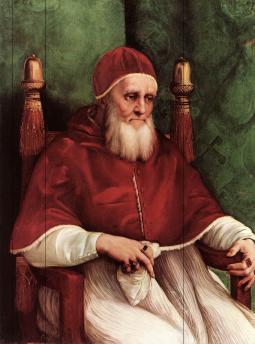The Papacy of the Renaissance encompassed the line of popes from the conclusion of the Great Schism to the beginning of the Reformation in the early 16th century. The papacy had maintained its supremacy, although their moral ethics had overshadowed their ability to rule as religious figures. The Catholic Church was on the decline, and the popes were exerting their warlike efforts on society.
However, there was still a focus on cultural affairs, as Rome was becoming a literary and artistic center of the Renaissance. It quite simply was a time where the latter overshadowed the pope's duties as spiritual leaders to the people.
The efforts of the popes during the Renaissance was much more focused on bloodshed than spiritual enlightenment. Julius II, the "warrior pope", led armies against his enemies, much to the surprise and disgust of his Christian followers. The direction was aimed at territorial claims in the Papal States; however, war was a topic of the church and in their teachings and the intellectuals of the time made that abundantly clear in their writings.
Consider Machiavelli who once wrote in The Prince "If any one should ask of me how comes it that the Church has attained such greatness in temporal power, seeing that from Alexander backwards the Italian potentates (not only those who have been called potentates, but every baron and lord, though the smallest) have valued the temporal power very slightly". Was his observation so far from the truth?
To make matters more complicated, popes were not hereditary monarchs and could not build on their holdings and wealth, so they relied on nepotism to promote their families' interests. Pope Sixtus IV gave his nephews church offices to build up their wealth, and Alexander VI encouraged his son Cesare to claim an Italian state from the territories of the Papal States.
Although the act of war and the accumulation of wealth was of great importance at the time, so were the cultural efforts of the popes to transform Rome. Pope Julius II tore down Saint Peter's Basilica, a church originally commissioned by Constantine, and rebuilt what we see today. Leo X was also directly involved as a participant of cultural advancement, however not in a matter of policy.

After Lorenzo became a cardinal at the age of 13, he acquired a taste for the arts, manners, and social life of the Renaissance. He became the pope at age 37 and commissioned Raphael to paint Saint Peter's. Shortly after, construction was accelerated in Rome to concrete its position as the artistic capital.
Although the papacy of the Renaissance did experience a decline, there was still an evident move towards a more culturally enlightened existence. Current religious practices were questioned and humanists offered their view on issues of the church. It was time of unanswered questions about tradition and the direction the medieval society and church was taking.
However, there was still a focus on cultural affairs, as Rome was becoming a literary and artistic center of the Renaissance. It quite simply was a time where the latter overshadowed the pope's duties as spiritual leaders to the people.
The efforts of the popes during the Renaissance was much more focused on bloodshed than spiritual enlightenment. Julius II, the "warrior pope", led armies against his enemies, much to the surprise and disgust of his Christian followers. The direction was aimed at territorial claims in the Papal States; however, war was a topic of the church and in their teachings and the intellectuals of the time made that abundantly clear in their writings.
Consider Machiavelli who once wrote in The Prince "If any one should ask of me how comes it that the Church has attained such greatness in temporal power, seeing that from Alexander backwards the Italian potentates (not only those who have been called potentates, but every baron and lord, though the smallest) have valued the temporal power very slightly". Was his observation so far from the truth?
To make matters more complicated, popes were not hereditary monarchs and could not build on their holdings and wealth, so they relied on nepotism to promote their families' interests. Pope Sixtus IV gave his nephews church offices to build up their wealth, and Alexander VI encouraged his son Cesare to claim an Italian state from the territories of the Papal States.
Pope Julius II
Although the act of war and the accumulation of wealth was of great importance at the time, so were the cultural efforts of the popes to transform Rome. Pope Julius II tore down Saint Peter's Basilica, a church originally commissioned by Constantine, and rebuilt what we see today. Leo X was also directly involved as a participant of cultural advancement, however not in a matter of policy.
Saint Peters Basilica

After Lorenzo became a cardinal at the age of 13, he acquired a taste for the arts, manners, and social life of the Renaissance. He became the pope at age 37 and commissioned Raphael to paint Saint Peter's. Shortly after, construction was accelerated in Rome to concrete its position as the artistic capital.
Although the papacy of the Renaissance did experience a decline, there was still an evident move towards a more culturally enlightened existence. Current religious practices were questioned and humanists offered their view on issues of the church. It was time of unanswered questions about tradition and the direction the medieval society and church was taking.








0 Comments:
Post a Comment
We appreciate comments, but we delete SPAM.